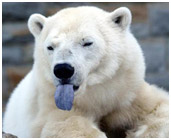Polar Bear is a beautiful animal found in the cold regions of the world. Check out some amazing & interesting facts & information on polar bears, including where do they live.
Polar Bear Facts
Polar bears are amongst the most fascinating and most beautiful animals in the world today. Polar bears, also known as ‘sea bears’, are the largest land meat-eater in the world. Captivating carnivores as these are, polar bears are perfectly adapted to survive in extremely ice cold winters and they live on a sea ice habitat. They are basically found inhabiting the countries of Russia, Norway, Greenland (Denmark), Alaska (United States) and Canada. With the global warming and the resultant shrinking of sea ice, polar bears have become an endangered species. Though there has been no proper census on the population of polar bears in the world, their number is expected to be somewhere around 20,000 to 25,000 bears, with about sixty percent of the population living in Canada. If you want to know more about polar bears, check out some amazing information and facts given about them in the following lines.

Fast Facts
Common Names: Polar Bear, Sea Bear, Nanook (Inuit), Wapusk (Cree), Lord of the Arctic, etc.
Class: Mammalia (Mammals)
Order: Carnivora (Carnivores)
Family: Ursidae (Bear Family)
Genus: Ursus
Species: Maritimus
Height (on all fours): about 1m (3½ inches)
Height (on hind legs): around 3 m (10 inches)
Weight (males): 550 kg (1200 lbs)
Weight (females): 300 kg (660 lbs)
Paws: Up to 30 cm (12 inches) across
Teeth: 42, which grow a little each year
Tail: 10 cm (4 inches) long
Running Speed: Up to 40km/h (25 mph) for short distances
Swimming Speed (small distances): Up to 10km/h (6 mph)
Swimming Speed (large distances): Up to 96km (60 mph)
Age: 20-30 years
Oldest Captive Polar Bear: 41 years
Oldest Wild Polar Bear: 32 years
Natural Habitat (where do polar bears live): Russia, Norway, Greenland (Denmark), Alaska (United States) & Canada
Diet: Seals, Beluga Whales, Walruses and, sometimes, seaweed
Reproductive Age: 4-5 years
Number of Offspring: Two
Interesting Information about Polar Bears
- Male polar bears are known as boars and female polar bears are known as sows.
- A group of polar bears is called a ‘celebration’.
- Polar bears hear the same range of sounds as people.
- Polar bears have good eyesight, with excellent depth perception.
- Polar bear have a sharp sense of smell and can detect a seal buried 3 inches-deep in snow, from 1 km away.
- Polar bears can dive about 4.5 m (15 inches) underwater.
- A polar bear's coat is about 2.5 to 5 cm (1-2 inches) thick.
- There is a thick layer of fatty-blubber inside the body of a polar bear, which helps him warm.
- Under the pure white hair, the skin of a polar bear is totally black.
- Polar bears have partly webbed paws making them outstanding swimmers. They can swim in a dog paddle style using their paws to move forward. Underneath the paws there is fur, which prevents them from skidding on ice.
- The fur on the polar bear’s body is water-resistant and it is not white in color, but hollow. The light reflects on the fur and the sun’s heat is trapped within the hair to keep the polar bear warm.
- Polar bears curl up and cover their muzzles with their paws to save heat.
- Polar bears have three hunting styles. Most popular hunting method is called as ‘still-hunting’ in which the bear locates a seal in a hole and crouches nearby only to pull out the seal and devour. The other method of theirs is stalking a seal silently and crouching at intervals and then attacking suddenly. To hunt, these bears also search birth nests where female seals are reproducing baby seals.
- Play-fighting among adults and cubs are natural behaviour of polar bears. This behaviour can be seen especially during the mating season.
See also
More in 'Society'
More from iloveindia.com
- Home Remedies | Ayurveda | Vastu | Yoga | Feng Shui | Tattoos | Fitness | Garden | Nutrition | Parenting | Bikes | Cars | Baby Care | Indian Weddings | Festivals | Party ideas | Horoscope 2015 | Pets | Finance | Figures of Speech | Hotels in India : Delhi | Hyderabad | Chennai | Mumbai | Kolkata | Bangalore | Ahmedabad | Jaipur
- Contact Us Careers Disclaimer Privacy Policy Advertise With Us Lifestyle Sitemap Copyright iloveindia.com. All Rights Reserved.




